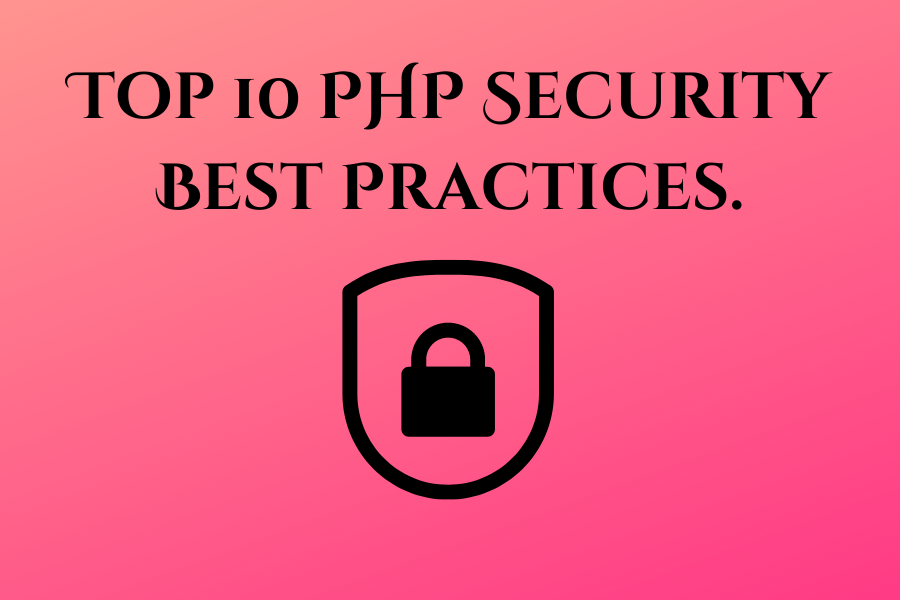Top 10 PHP Security Best Practices.
In today’s digital landscape, security is a paramount concern for developers and users alike. With the increasing sophistication of cyber threats, ensuring the security of web applications is more critical than ever. PHP, being one of the most widely used server-side scripting languages, powers millions of websites and applications. However, its popularity also makes it a prime target for attackers.
As a PHP developer, it is your responsibility to safeguard your applications and user data from potential threats. Whether you’re building a small personal project or a large-scale enterprise application, adhering to security best practices is essential. In this blog post, we will delve into the top PHP security best practices every developer should follow. From input validation and sanitization to secure session management and error handling, we’ll cover practical strategies to fortify your PHP applications against common vulnerabilities.
Join us as we explore these crucial practices, providing you with actionable insights and code snippets to enhance the security of your PHP projects. By the end of this post, you’ll have a solid understanding of implementing these best practices, ensuring your applications are robust, secure, and resilient against potential attacks. Let’s get started on the path to mastering PHP security!
Here are some top PHP security best practices for developers:
1. Input Validation and Sanitization
- Validate Input: Always validate and sanitize all user inputs to prevent attacks such as SQL injection, XSS, and CSRF.
- Use Built-in Functions: Use PHP functions like
filter_var()to validate data, andhtmlspecialchars()orhtmlentities()to sanitize output.
2. Use Prepared Statements
- SQL Injection Prevention: Always use prepared statements and parameterized queries with PDO or MySQLi to prevent SQL injection attacks.
$stmt = $pdo->prepare('SELECT * FROM users WHERE email = :email');
$stmt->execute(['email' => $email]);
3. Cross-Site Scripting (XSS) Prevention
- Escape Output: Escape all user-generated content before outputting it to the browser using
htmlspecialchars(). - Content Security Policy (CSP): Implement CSP headers to prevent the execution of malicious scripts.
4. Cross-Site Request Forgery (CSRF) Protection
- Use CSRF Tokens: Include a unique token in each form submission and validate it on the server side.
// Generating a CSRF token $_SESSION['csrf_token'] = bin2hex(random_bytes(32)); // Including the token in a form echo '';
5. Session Management
- Secure Cookies: Use secure and HttpOnly flags for cookies to prevent XSS attacks.
session_set_cookie_params([ 'lifetime' => 0, 'path' => '/', 'domain' => '', 'secure' => true, // Only send cookies over HTTPS 'httponly' => true, // Prevent access via JavaScript 'samesite' => 'Strict' // Prevent CSRF ]); session_start();
- Regenerate Session IDs: Regenerate session IDs frequently, particularly after login, to prevent session fixation.
session_regenerate_id(true);
6. Error Handling and Reporting
- Disable Error Display: Do not display errors in production. Log errors to a file instead.
ini_set('display_errors', 0);
ini_set('log_errors', 1);
ini_set('error_log', '/path/to/error.log');
7. Secure File Handling
- File Uploads: Validate and sanitize file uploads. Restrict file types and ensure proper permissions are set on uploaded files.
$allowed_types = ['image/jpeg', 'image/png'];
if (!in_array($_FILES['file']['type'], $allowed_types)) {
die('File type not allowed');
}
8. Secure Configuration
- Use HTTPS: Always use HTTPS to encrypt data transmitted between the client and server.
- Secure Configuration Files: Restrict access to configuration files. Store sensitive information like database credentials securely.
9. Keep Software Updated
- Update PHP and Libraries: Regularly update PHP, frameworks, and libraries to the latest versions to patch security vulnerabilities.
10. Use Security Headers
- Set Security Headers: Use headers like
X-Content-Type-Options,X-Frame-Options,X-XSS-Protection, andStrict-Transport-Securityto enhance security.
header('X-Content-Type-Options: nosniff');
header('X-Frame-Options: SAMEORIGIN');
header('X-XSS-Protection: 1; mode=block');
header('Strict-Transport-Security: max-age=31536000; includeSubDomains');
By following these best practices, PHP developers can significantly enhance the security of their applications and protect against common vulnerabilities and attacks.
